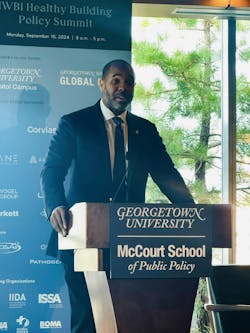Clearing the Air: Insights from the Inaugural IWBI Healthy Building Policy Summit (Part 1)
[Editor’s note: This is the first installment of a two-part report on the inaugural IWBI Healthy Buildings Summit held in Washington, D.C., on Sept. 16th. Read the second installment.]
If you’re reading this, the chances are high you’re in an indoor environment, given that we spend 90% of our time indoors. Now, take a deep breath.
How certain are you that the air in your building is clean or at least not going to make you sick? Unless your facility is equipped with indoor air quality sensors, you’re probably not sure.
That’s a problem more significant than many building owners and facilities managers realize. And it’s a challenge that was addressed head on at the inaugural International WELL Building Institute (IWBI) Healthy Building Policy Summit held at the Georgetown University McCourt School of Public Policy in Washington, D.C., on Sept. 16, for which BUILDINGS served as a media sponsor. The McCourt School’s new building, designed during the COVID pandemic, has achieved LEED Platinum designation and was the perfect backdrop for the event, which was the first public gathering in the space following its ribbon cutting ceremony.
Indeed, the synergy in the room was palpable, as opening plenary speaker Elliot Doomes, commissioner of the Public Buildings Service for the U.S. General Services Administration (GSA), observed. “As I see it, our collective missions of IWBI, McCourt, and the Public Buildings Service have a lot in common,” he said. “I see the important role the policy plays in ensuring the health of building occupants.”
Doomes noted that the GSA is actively working on improving indoor air quality (IAQ) and daylighting across the agency’s 8,397 buildings representing over 360 million square feet of space, before addressing “the elephant in the room”: most of the agency’s building repairs remain unfunded, resulting in $5 billion in deferred maintenance costs. “Addressing this shortfall is essential to achieving and maintaining our goals,” he said. “We’re at a pivotal moment where technology and policy will move us toward best practice. […] We are going to continue to advocate for the health and wellbeing of the employees and people that we serve.”
The Future of Work
The morning continued with an eye-opening panel discussion titled, “Designing for All: The Future of Work,” featuring industry leaders Dr. Amy Kenny, director of Georgetown University’s Disability Cultural Center; Dr. Yele Aluko, chief medical officer at EY Americas; Kay Sargent, senior principal and director of thought leadership at HOK; and moderated by Whitney Austin Gray, IWBI’s senior vice president for research.
Sargent noted that her firm has been at the forefront of designing with human health in mind and supporting IWBI’s WELL rating system, underscoring the importance of embracing the art and science of design to create workplaces that don’t have a negative impact on people’s health.
“We don’t look at this as a competitive advantage; we look at it as a moral imperative,” Sargent said.
Dr. Kenny, a disabled scholar-practitioner, writer, and advocate, noted that nearly a quarter of the population has some form of disability, so designing offices that accommodate disabled people is vitally important. “I’m really wanting us to think about accessibility where ADA is a floor, not a ceiling, where we can all thrive,” she said, adding, “You might not know it, but you’re already benefiting from disability culture.” The ubiquitous touch screen, for example, was designed for people with visual or dexterity challenges—yet it is a technology from which we all benefit.
Likewise, Dr. Aluko pointed out that “the strategy of providing value to a vulnerable population invariably enhances value for all populations.” He added that many underserved communities are devoid of strategic urban planning that promotes health opportunities, and that government policy should come with accountability and go beyond standards, regulations, and guidelines.
When it comes to neurodiversity in the workplace, Sargent said every person in the room is impacted by sound, light, temperature, and smell—but those who are neurodivergent simply notice the environment first. She highlighted the fact that currently there is “a race to determine what neurodiversity looks like” and urged the industry “to put down their swords to put out a policy, a standard, and a set of recommendations to address this.”
Because, ultimately, we as an industry can no longer afford to ignore the issue of building health. “It takes just as much money to design something poorly, but it will cost you incredibly more over the long time than you can possibly imagine,” Sargent concluded.
Advancing Human and Environmental Health
The morning continued with remarks from IWBI’s Executive Chairman, Rick Fedrizzi, who characterized the current moment we’re in as the “second wave of sustainability.” In the first, the industry was focused on planetary health—water, waste, materials, and toxins—and the need to address those issues. Thirty years later, we are experiencing the second wave in which “we’re not only talking about planetary health, but a laser-focused, deep dive into human health,” Fedrizzi observed. “You have the planet, and you have people; those two are intrinsically linked. You will never separate those things. They go together in every regard,” he added.
If we insist on evidence-based strategies and a people-first design ethic, Fedrizzi said, buildings can unequivocally improve human health and well-being. “If the pandemic taught us anything, [it’s that] buildings must be part of the public health agenda,” he added.
Fedrizzi’s remarks provided a perfect transition into the panel discussion that followed titled, “Health + Sustainability: Advancing Planetary Health and Human Health,” moderated by Uwe Brandes, director of Georgetown’s Global Cities Initiative, and joined by panelists Holly Paeper, president, Commercial, HVAC, Americas at Trane, and Lisa Jacobson, president of the Business Council for Sustainable Energy.
Building on Fedrizzi’s “second wave” theme, the panel addressed the risks associated with industry stakeholders continuing to focus solely on energy rather than health. Paeper noted that the danger lies in the interconnectedness of building, occupant, and planetary health. She noted that indoor and outdoor air are intrinsically connected, and many of Trane’s customers rely on fresh, outdoor air to provide good indoor air in their buildings. “If the outdoor air isn’t fresh, what happens to your indoor environment? If you’re only solving for one aspect of this, you miss the opportunity to look at the building holistically and the value proposition it provides,” she said.
“From a policy perspective, without proper education, there’s a risk that we miss opportunities or create policies that are not optimal,” Jacobson said. She added that there’s a lack of awareness among many policy makers, building owners, and industry professionals, urging the audience as stakeholders to educate them on how technology has evolved and how their investment in building health will pay off. “They can have their energy efficiency or climate benefits and improve the health and wellbeing of their occupants,” Jacobson added.
Paving the Way for IAQ Policy
The morning wrapped up with a discussion exploring IAQ in a panel titled, “The Future of Indoor Air & What Policymakers Need to Know.” The esteemed panel of experts included Dr. Rebecca Katz, professor and director of the Center for Global Health Science and Security at Georgetown University, who served as moderator; Kenneth Mendez, president and CEO of the Asthma and Allergy Foundation of America (AAFA); Dr. Linda Lee, chief medical affairs andscience officer at UV Angel; Dr. John McKeon, CEO of iAIR Institute; and Seema Bhangar, principal of Healthy Buildings and Communities, Innovation and Research for the U.S. Green Building Council (USGBC).
When asked if there’s been enough of a focus on indoor air quality, the panel agreed there’s greater awareness of the importance of IAQ, but more needs to be done. “It’s a quality and not a quantity game,” as Bhangar aptly noted. She suggested the industry and policymakers need to move into a new phase with greater, lasting impact that requires three focus areas: “more research and more learning from what we’re doing that we haven’t done before in buildings; more attention to equity and vulnerable populations, not just in intention but by planning strategically and with accountability; and more coherence in strategy for our collective efforts.”
Dr. McKeon said if you look at where money is spent in terms of human health in the U.S., “You have a sickness reimbursement program, not a healthcare program.” He suggests we completely rethink where we’re spending money and shift dollars away from merely “rescuing people from healthcare crises” and funnel them toward proactive, preventative health measures such as building health.
“There are more water regulations in this country than there are air regulations,” Dr. Lee said, noting that we wouldn’t accept a drink of water from a stranger, and yet we breathe the air in buildings without a second thought. “If I had a message to policymakers, [it would be to] spend more time on focusing on the air which is making people sick. What is it that’s going to protect us as a society?”
In terms of the building solutions that will help tackle the indoor air quality and health challenges we face, Dr. MacKeon said sensor technologies and CO2 monitors will provide a breakthrough. Mendez agreed but underscored the importance of convincing employers that it’s worth investing in healthy buildings. “It’s important for building owners to understand that this represents a tremendous return on investment for people who occupy those buildings.”
As the final morning session wrapped up, panelists were asked what policy change they’d like to see with the most impact on building and human health. Bhangar recommended policymakers focus on “better resilience planning for extreme events and other things related to how we’re doing things differently now. What I have in my head is a map of the U.S. where we really look at where is there extreme risk, extreme vulnerability, and how do we address those hot spots?”
“I would like to see a regulation similar to what we have for clean water and clean air,” Dr. Lee said, “maybe having a standard on airborne pathogens.”
If there’s one thing Dr. McKeon would like to see is “a flip on metrics. […] We need a hard ROI on human health.”
Mendez agreed, noting that “we have EPA outdoor air quality standards; we need something for indoor air quality for asthma and allergies.”
As we face increasing environmental and health challenges, the future of workspaces must prioritize both planetary and human health, ensuring safer, healthier indoor environments for all—a point made abundantly clear in the morning sessions of the Healthy Buildings Policy Summit.
Check out part 2 of this article with more in-depth coverage from this groundbreaking event.







